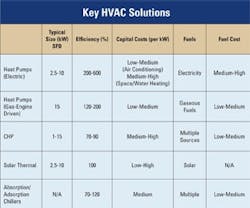How Much Can HVAC Technology Slow Carbon Emissions?
What would it take to halt the increase of global carbon emissions before 2020 and reduce existing greenhouse gases by at least 50% by 2050?
Experts at the Risø International Energy Conference in Denmark advocate using "off-the-shelf" technologies to create a sustainable global energy system. As long as the solutions can respond to fluctuations in energy consumption, intelligent energy systems are within reach.
The most accessible improvements may be heating and cooling systems, suggests the International Energy Agency (IEA). Research by the IEA suggests solar thermal, heat pumps, thermal energy storage, and combined heat and power may reduce CO2 emissions by up to 2 gigatons (Gt) by 2050 – around 25% of today's emissions from buildings.
These technologies are ready to be integrated into existing facilities:
- Active solar thermal systems heat water for space heating or sanitary hot water.
- Heat-pump systems have high end-use efficiencies and can produce heat and cold simultaneously or separately.
- Combined heat and power systems simultaneously yield heat and electricity for building use or for sale to the grid. Heat can be used for space and water heating or cooling with a thermally driven chiller.
- Thermal energy storage facilitates greater use of renewable energy, enables optimal operation of heating and cooling systems, and provides increased flexibility in balancing energy systems.
Within the next 30 years, these HVAC technologies could cut fossil fuels' share in useful space and water heating by 5-20%, while the global average efficiency would need to be doubled.
These energy savings can be achieved rapidly because heating and cooling equipment is replaced several times during a building's lifespan, providing multiple opportunities to increase efficiency.
